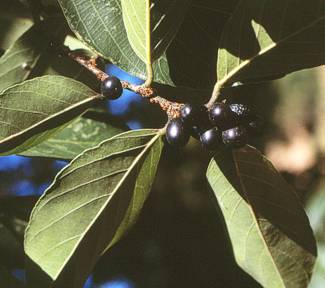Bridelia micrantha
Bridelia micrantha (Hochst.) Baill.
Family: Phyllanthaceae
Common names: mitseeri, bruin stinkhout (Afr.); motsere (Sotho); ndzerhe (Tswana)
SA Tree No: 324
Introduction
Beautiful, fast growing shade tree, usually with scattered bright red leaves.

Description
Description
Medium to large deciduous tree up to 20 m with spreading crown. Bark greyish brown, flaky, rough in older specimens, sometimes with small blunt spines at bottom of trunks or on branches; twigs with lenticels. Leaves alternate, elliptic to obovate, 40-180 x 25-120 mm, usually 70-80 x 35-40 mm, dark green, glossy above, paler green below, frequently bright orange in autumn; lateral veins often yellowish, running straight to the margin and forming a herring-bone pattern; apex tapering to rounded, margin entire.

Flowers in small tight yellow clusters in axils of leaves (Oct.-Dec.). Fruit an oval berry, 8 x 4 mm, black when mature, edible and sweet tasting (Jan.- Mar.).

Conservation Status
Status
The Red Data status of Bridelia micrantha is of Least Concern (LC).
Distribution and habitat
Distribution description
Bridelia micrantha is found in coastal, riverine and swamp forest, usually in moist places in the Eastern Cape, KwaZulu-Natal, Limpopo Province, in the Lower Sourveld of Mpumalanga, in Zimbabwe and up to Ethiopia and Senegal. Able to withstand some degree of frost.
Derivation of name and historical aspects
History
Micrantha means with small flowers.
The Euphorbiaceae is a large family of herbs and trees characterized by one or more of the following features: succulent leafless branches; milky or watery latex; glands at the leaf base; and 3-lobed fruit. The family comprises 326 genera and 7 750 species worldwide and is the second largest tree family in southern Africa.
Ecology
Ecology
Bridelia micrantha is a larval food plant for butterflies such as Abantis paradisea, Charaxes castor flavifasciatus and Parosmodes morantii morantii.
Uses
Use
The wood is dark brown, fine grained and is resistant to termites. It can be used to make fine furniture.
The bark of Bridelia micrantha is used to treat burns, wounds, venereal diseases, tapeworm, diarrhoea and toothache. Leaf sap is used to treat sore eyes. Root is used to treat stomach pains, possibly gastric ulcers, or can be powdered and mixed with fat or oil and rubbed into the head to cure headaches.
It is a fast growing, beautiful shade tree for large gardens.

Growing Bridelia micrantha
Grow
Bridelia micrantha is easily grown from fresh seed. Plant seeds in seed trays filled with seedling soil or a mixture of river sand and sifted compost (1:1) and keep moist.
References
- Coates Palgrave, M. 2002. Keith Coates Palgrave Trees of southern Africa, edn 3. Struik, Cape Town.
- Schmidt, E., Lötter, M. & McCleland, W. 2002. Trees and shrubs of Mpumalanga and Kruger National Park. Jacana, Johannesburg.
- Smith, C.A., 1966. Common names of South African plants. Memoirs of the Botanical Survey of South Africa No. 35.
- Van Wyk, A.E.(Braam) & Van Wyk, P. 1997. Field guide to trees of southern Africa. Struik Publishers, Cape Town.
Credits
Alec Naidoo
Pretoria National Botanical Garden
January 2010
Plant Attributes:
Plant Type: Tree
SA Distribution: Eastern Cape, KwaZulu-Natal, Limpopo, Mpumalanga
Soil type: Sandy
Flowering season: Early Summer
PH: Acid
Flower colour: Green, Yellow
Aspect: Full Sun
Gardening skill: Average
Special Features:
Horticultural zones










Rate this article
Article well written and informative
Rate this plant
Is this an interesting plant?
Login to add your Comment
Back to topNot registered yet? Click here to register.